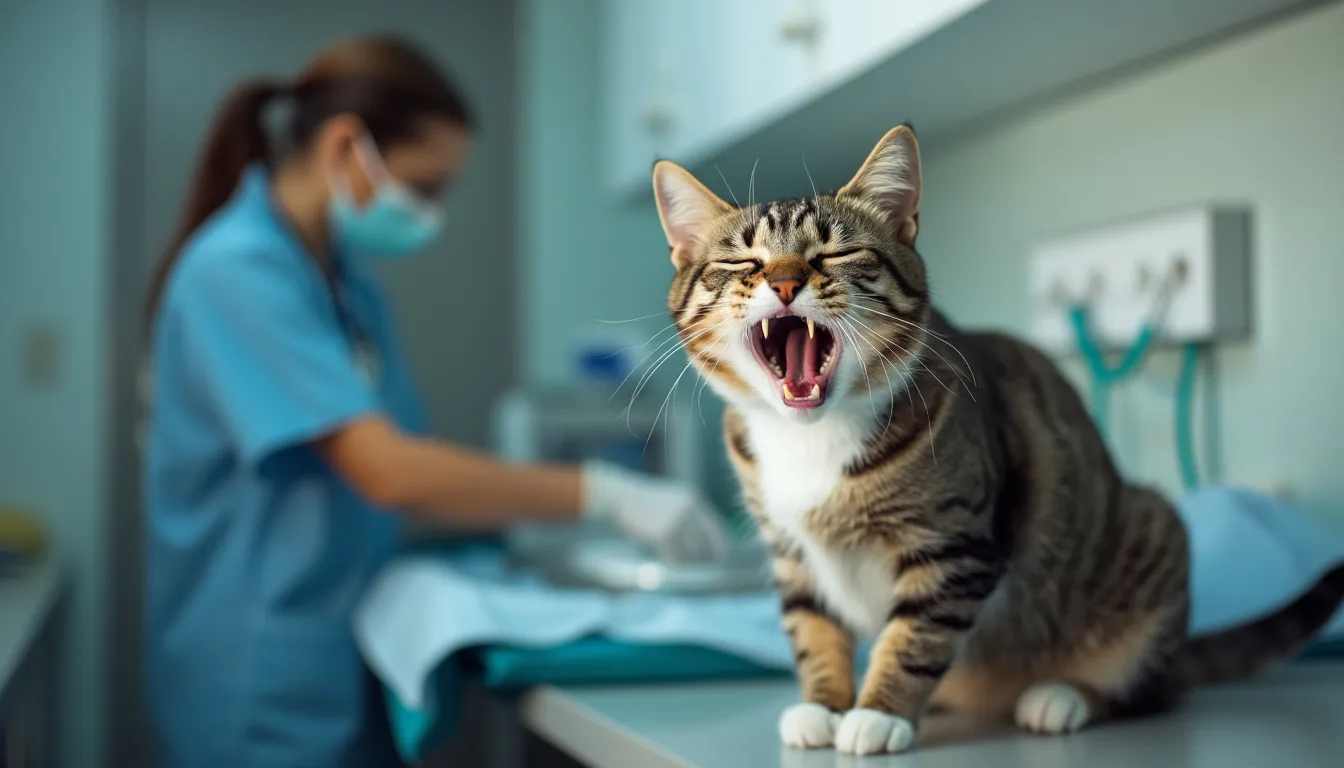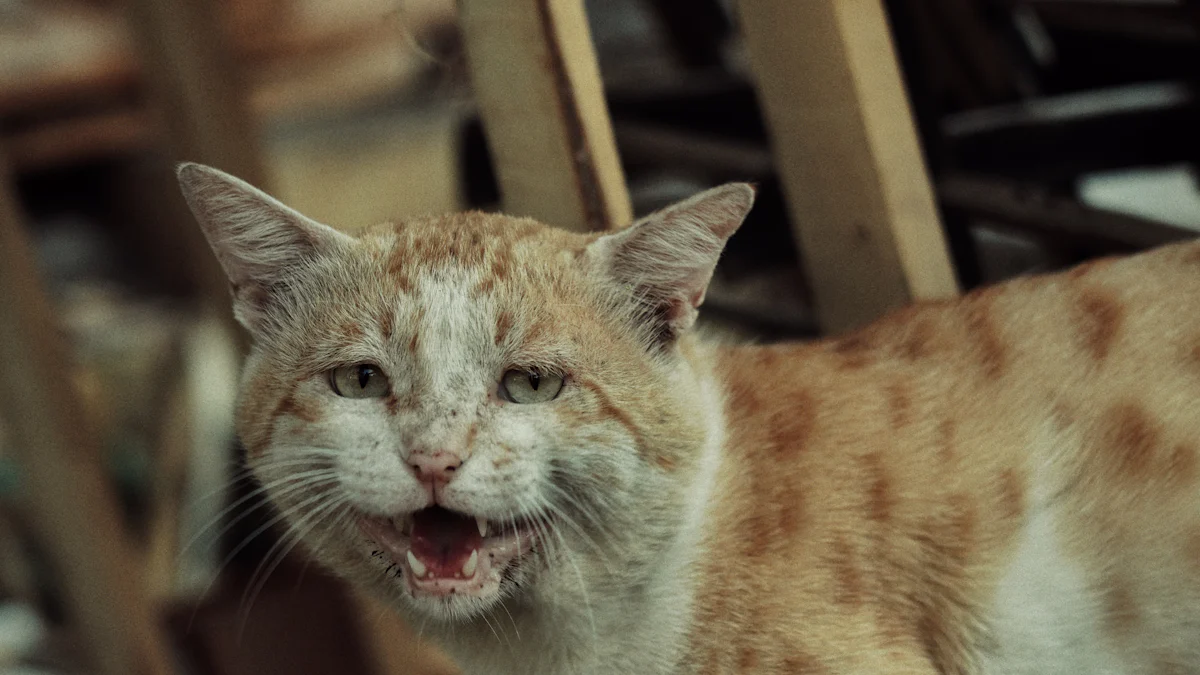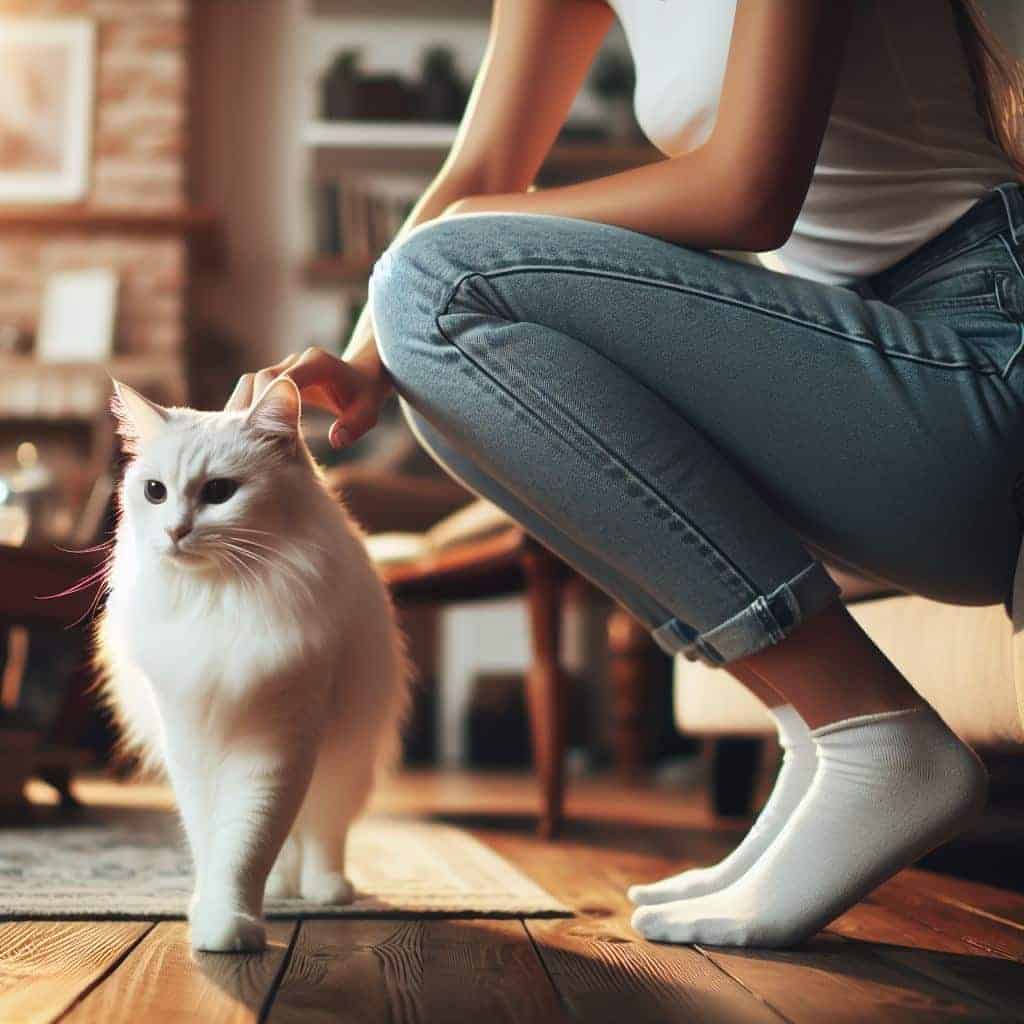
Cats may cry when in pain, but understanding their cries isn’t always straightforward. Unlike humans, cats don’t shed tears to express discomfort. Instead, they communicate through various vocalizations such as growling, howling, or yowling. These sounds can indicate distress or physical pain. Recognizing these signs could be vital for your cat’s health and well-being. Always pay close attention to changes in their behavior and vocal patterns – doing so will ensure your feline friend receives the care they need promptly.
Do Cats Cry When in Pain?
Understanding whether cats cry when in pain can be challenging. You might wonder if your feline friend is trying to tell you something when they vocalize differently. Cats don’t shed tears like humans, but they do have their own ways of expressing discomfort.
Recognizing these signs helps you provide the care your cat needs.
Understanding Cat Vocalizations
Cats communicate through a variety of vocalizations. When a cat is in pain, these sounds can change significantly. You might hear growling, howling, or yowling, these are common indicators of distress. According to research, cats can produce different types of vocalizations depending on the context, including situations of pain. These vocalizations are influenced by genetics and past experiences, making each cat’s cries unique.
-
Growling: Often a sign of fear or aggression, but can also indicate pain.
-
Howling: A loud, drawn-out sound that suggests significant discomfort.
-
Yowling: Similar to howling, but may be more frequent and intense.
These vocalizations can be confusing, especially if you’re not familiar with your cat’s usual sounds. Pay attention to any changes in their vocal patterns, as this could be a sign that your cat is crying out for help.
Emotional vs. Physical Crying
It’s important to differentiate between emotional and physical crying in cats. While cats don’t cry tears from sadness, they do express emotions through their behavior and vocalizations. Emotional crying might manifest as increased meowing or purring, often used as a self-soothing mechanism.
-
Emotional Crying: Includes sounds like purring or soft meows, which can indicate contentment or mild distress.
-
Physical Crying: More intense vocalizations like yowling or howling, often linked to pain or discomfort.
Understanding these differences can help you determine the reasons cats cry and whether your cat is experiencing physical pain. If you notice your cat crying more than usual, consider their environment and any recent changes that might have affected them. This awareness can guide you in addressing their needs effectively.
Signs of Pain
Behavioral Changes
Cats often exhibit noticeable behavioral changes when experiencing pain. You might observe your cat becoming more withdrawn or less interactive. Overly anxious cats may display increased aggression or irritability, especially when touched.
These changes can be distressing, but they are vital clues to your cat’s condition.
-
Withdrawal: Your cat might isolate itself, avoiding interaction with family members or other pets.
-
Aggression: A usually calm cat may become irritable, lashing out unexpectedly.
-
Changes in Grooming: Cats in pain might reduce their grooming habits, leading to a matted coat. Conversely, some cats might engage in heavy grooming, focusing excessively on a specific area.
Behavioral changes can also include alterations in eating and drinking habits. A cat in pain might eat less or refuse food altogether. This change can lead to weight loss and further health complications.
Monitoring these behaviors helps you identify potential issues early.
Physical Indicators
Physical signs of cat pain can be more apparent if you know what to look for. Cats may exhibit changes in posture or facial expressions. For instance, a cat in pain might sit hunched over with its head lowered and back arched higher than usual.
This posture indicates discomfort and should not be ignored.
-
Posture Changes: Look for a hunched back or a cat lying with legs tucked underneath.
-
Facial Expressions: Cats in pain might squint, close their eyes, or flatten their ears. Their cheeks, nose, and mouth may appear tense.
-
Limping or Difficulty Moving: Cats experiencing pain might limp or show reluctance to jump onto surfaces they previously navigated with ease.
Physical symptoms can also include changes in bowel habits. Cats might experience bowel disorders, leading to straining or difficulty using the litter box. Recognizing these signs of cat pain allows you to take appropriate action. Consult a veterinarian if you notice any of these symptoms. Early intervention can prevent further complications and improve your cat’s quality of life.
What Can You Do?

When you notice your cat showing signs of pain, you might feel worried and unsure about the next steps. Your quick response can make a significant difference in your cat’s recovery and comfort. Here are some immediate actions you can take to ensure your feline friend receives the care they need.
Immediate Steps
-
Observe and Document: Pay close attention to your cat’s behavior and physical condition. Note any changes in vocalizations, posture, or habits. This information will be invaluable when you consult a veterinarian.
-
Provide Comfort: Create a quiet and comfortable space for your cat. Ensure they have easy access to their favorite resting spots, food, and water. Avoid handling them excessively, as this might increase their discomfort.
-
Assess the Severity: Determine if the pain seems mild or severe. For mild symptoms like slight limping or minor behavioral changes, schedule an appointment with your veterinarian. However, if your cat refuses to move, vocalizes frequently, hides more than usual, or stops eating or drinking, seek emergency veterinary care immediately. Severe pain can escalate quickly, and early intervention is crucial.
-
Consider Pet Insurance: If you haven’t already, explore pet insurance options. It can help manage the cost of unexpected veterinary visits and treatments. Many pet insurance plans cover a range of services, including emergency care and pain management.
Consulting a Veterinarian
Your veterinarian plays a vital role in diagnosing and treating your cat’s pain. They can provide expert guidance and recommend appropriate treatments. Here’s what to expect when consulting a veterinarian:
-
Diagnosis and Treatment Plan: The veterinarian will conduct a thorough examination to identify the cause of your cat’s pain. They may recommend diagnostic tests such as X-rays or blood work. Based on the findings, they will develop a treatment plan tailored to your cat’s needs.
-
Pain Management Options: Discuss pain management options with your veterinarian. They might suggest medications, physical therapy, or alternative therapies like acupuncture. In some cases, consulting a veterinary pain management professional may be necessary to explore additional treatments.
-
Follow-Up Care: Regular follow-up appointments are essential to monitor your cat’s progress. Your veterinarian will adjust the treatment plan as needed to ensure your cat’s comfort and recovery.
-
Cost Considerations: Veterinary care can be costly, especially for complex cases. Discuss the cost of treatments and procedures with your veterinarian. If you have pet insurance, review your policy to understand what is covered. This can help you manage expenses and make informed decisions about your cat’s care.
Taking these steps can significantly improve your cat’s quality of life and ensure they receive the care they deserve. Your prompt action and collaboration with a veterinarian are key to addressing your cat’s pain effectively.
Key Concerns | Implications
Health Risks of Ignoring Pain
Ignoring your cat’s pain can lead to severe health risks. Cats often hide their discomfort, making it challenging to detect issues early. When you overlook these signs, minor problems can escalate into serious conditions.
For instance, untreated dental issues can lead to infections, affecting your cat’s overall health. Similarly, arthritis can worsen without intervention, severely limiting your cat’s mobility.
-
Infections: Untreated pain from infections can spread, causing more significant health problems.
-
Arthritis: This condition can lead to joint damage, making basic tasks like jumping or grooming difficult.
-
Dental Problems: Ignoring dental pain can result in tooth loss and systemic infections.
Veterinary medicine has made strides in recognizing and treating pain in cats. Early diagnosis and treatment are crucial. You should stay alert to subtle signs of pain, such as changes in behavior or mobility. Erring on the side of caution ensures your cat’s long-term health and well-being.
Emotional Well-being of Your Cat
Your cat’s emotional well-being is closely linked to its physical health. Pain can cause stress and anxiety, affecting your cat’s quality of life. A cat in pain may become withdrawn or aggressive, impacting its relationship with you and other pets. Addressing pain promptly helps maintain your cat’s emotional balance.
-
Stress and Anxiety: Pain can increase stress levels, leading to behavioral changes.
-
Aggression: A cat in pain might lash out, affecting its interactions with family members.
-
Withdrawal: Pain can cause your cat to isolate itself, reducing its engagement with its environment.
Understanding your cat’s unique behavior and responses to pain is essential. Catching and managing pain early is key to keeping your cat’s mood and body in check. This way, your furry buddy can enjoy a joyful and cozy life.
What Else to Know?
Understanding the common causes of pain in cats and how to prevent them is essential for any cat owner. You want your feline friend to live a happy, healthy life, free from discomfort.
Let’s go through some of the typical reasons cats experience pain and what you can do to prevent it.
Common Causes of Pain in Cats
Cats, like humans, can suffer from various conditions that cause pain. Recognizing these can help you take proactive steps to ensure your cat’s well-being.
-
Arthritis: As cats age, they often develop arthritis, leading to joint pain and stiffness. This condition can significantly impact their mobility and quality of life. Aging cats are particularly susceptible, and it’s crucial to monitor their behavior for signs of discomfort.
-
Dental Issues: Dental problems, such as tooth decay or gum disease, can cause significant pain. Regular dental check-ups are vital to prevent these issues from escalating.
-
Injuries: Cats are curious creatures, and their adventurous nature can sometimes lead to injuries. Falls, fights, or accidents can result in sprains, fractures, or wounds that require immediate attention.
-
Chronic Conditions: Conditions like interstitial cystitis or lower urinary tract disease can cause chronic pain. These often manifest as changes in litter box habits or increased aggression due to discomfort.
-
Aging: As cats grow older, they may experience various health issues that contribute to pain. Regular veterinary check-ups can help catch these early and manage them effectively.
Scientific Research Findings:
-
Chronic arthritic pain can lead to house-soiling problems and pain-related aggression.
-
Multi-dimensional response to pain includes altered behavior and movement.
Preventive Measures
Preventing pain in cats involves a combination of regular veterinary care, a healthy lifestyle, and attentive observation. Here are some steps you can take:
-
Regular Check-Ups: Schedule routine visits to your veterinarian. The team at Cat Care Of Vinings can provide comprehensive assessments to catch potential issues early. They follow guidelines from the American Animal Hospital Association to ensure high-quality care.
-
Healthy Diet and Exercise: Ensure your cat maintains a balanced diet and regular exercise. This helps keep their weight in check and reduces the risk of arthritis and other health problems.
-
Environmental Enrichment: Provide a stimulating environment with toys and activities. This keeps your cat mentally and physically active, reducing stress and promoting overall well-being.
-
Pain Management: If your cat shows signs of pain, consult with your veterinarian about appropriate treatments. The team at Cat Care can recommend options to treat cat pain, including medications or alternative therapies.
-
Kitten Care: Start preventive measures early. Proper kitten care sets the foundation for a healthy life, reducing the risk of pain-related issues as they age.
Comparison Table: Common Causes and Preventive Measures
|
Cause |
Description |
Preventive Measure |
|---|---|---|
|
Arthritis |
Joint pain and stiffness in aging cats |
Regular vet check-ups, healthy diet |
|
Dental Issues |
Tooth decay or gum disease |
|
|
Injuries |
Sprains, fractures from falls or accidents |
Safe environment, supervision |
|
Chronic Conditions |
Interstitial cystitis, urinary tract disease |
Monitor litter box habits, vet visits |
|
Aging |
Various health issues in older cats |
Comprehensive care, regular monitoring |
Taking these preventive measures can significantly enhance your cat’s quality of life. Remember, early intervention is key to managing and preventing pain.
Frequently Asked Question
Can Cats Hide Their Pain?
You might wonder if your cat can hide its pain. Cats are masters at concealing discomfort. This behavior stems from their wild ancestors, who needed to appear strong to avoid predators. As a result, your cat might not show obvious signs of pain. Instead, you may notice subtle changes in behavior or routine.
Survey Results:
-
Behavioral Indicators: Many cat guardians report that their pets become less social or more aggressive when in pain.
-
Grooming Habits: A decrease in grooming can signal discomfort. Cats often stop grooming when they feel unwell.
-
Routine Changes: Cats might alter their eating or sleeping patterns when experiencing pain.
Understanding these signs is crucial. You should pay close attention to any deviations from your cat’s normal behavior. Regular veterinary check-ups can help identify issues early. This proactive approach ensures your cat receives the care it needs.
How Can I Comfort My Cat at Home?
When your cat shows signs of pain, you want to provide comfort. Creating a soothing environment can help ease your cat’s distress. Here are some steps you can take:
-
Create a Safe Space: Ensure your cat has a quiet, comfortable area to rest. This space should be free from loud noises and disturbances.
-
Maintain Routine: Cats thrive on routine. Keeping feeding and playtime consistent can provide a sense of security.
-
Gentle Interaction: Approach your cat calmly. Avoid sudden movements or loud noises. Gentle petting can reassure your cat, but respect its boundaries.
-
Monitor Health: Keep an eye on your cat’s behavior and physical condition. Note any changes and consult your veterinarian if necessary.
-
Provide Enrichment: Toys and activities can distract your cat from discomfort. Interactive toys or puzzle feeders can engage your cat’s mind and body.
Comparison Table: Comfort Measures for Cats
|
Comfort Measure |
Description |
Benefits |
|---|---|---|
|
Safe Space |
Quiet, comfortable resting area |
Reduces stress and promotes relaxation |
|
Routine Maintenance |
Consistent feeding and play schedules |
Provides security and stability |
|
Gentle Interaction |
Calm, respectful handling |
Builds trust and reassurance |
|
Health Monitoring |
Observing behavior and physical changes |
Early detection of health issues |
|
Enrichment Activities |
Toys and puzzles for mental and physical engagement |
Distracts from discomfort |
These steps can help you support your cat’s well-being at home. Remember, your attentive care and understanding make a significant difference in your cat’s comfort and happiness.
Understanding whether cats cry when in pain is crucial for their well-being. Cats often hide their discomfort, making it essential for you to recognize subtle signs. Regularly consulting a veterinarian ensures your cat receives the care it needs. Implementing routine pain assessments helps address both physical and emotional needs. Preventive care, such as monitoring behavior changes helps in maintaining your cat’s health. Your attentive care can make a significant difference in your cat’s life.
Always prioritize your feline friend’s comfort and happiness by staying informed and proactive.

In her previous life, Lisa traveled extensively, both for work and leisure. After the pandemic struck, Lisa locked up her luggage and adopted a cat ever since.
Lisa is now an avid cat lover, she devotes most of her free time serving as butler to her adorable feline at home. When she is not with her cat, she can be seen using her phone sourcing for the latest cat supplies online.


